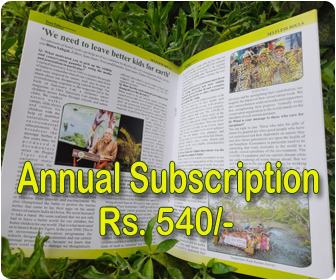Environment, nature, and tree plantation have become quite a fad, with all and sundry trying to get mileage out of them. But, where is the actual work being done in this direction (especially by the oh-so-concerned ‘talkaholics’)? If all were planting trees, we would be living in a lush world with healthy weather conditions- pleasant winters, cooler summers, and timely rains! As it is, the winters are getting shorter and terser, summers longer and extreme, while rains are either scant or heavy, causing floods in some places while drought in others. The worst weather is experienced in areas where, officially, the rains arrive, but it does not rain. The heat and humidity can prove fatal to all living beings (including plants)! Can this lack of rainfall be associated with a lack of enough greenery? Researchers have admitted to a multitude of ways in which forests/green cover create rain and cool local climates. How? Trees and forests increase rainfall intensity through the fungal spores, pollen, bacterial cells, and other particles they release into the atmosphere. Atmospheric moisture condenses when the air becomes sufficiently saturated with water, and does so much more readily when these particles are present.
We use the phrase ‘lungs of the planet’ all the time, but do we really understand it? Trees or green cover are not just breathing oxygen into us, but also helping make precious rain. Recent studies have shown that as much as 70 percent of the atmospheric moisture generated over land areas comes from plants (as opposed to evaporation from lakes or rivers) – much more than previously thought. In addition, new research has revealed that forests also play a key role in water vapour actually forming clouds and then falling as rain. Trees emit aerosols that contain tiny biological particles – fungal spores, pollen, microorganisms, and general biological debris – that are swept up into the atmosphere. Rain can only fall when atmospheric water condenses into droplets, and these tiny particles make that easier by providing surfaces for the water to condense onto. Some of these plant-based microorganisms even help water molecules to freeze at higher temperatures – a crucial step for cloud formation in temperate zones.
Besides that, tree roots – and the animals they attract like ants, termites, and worms – help to create holes in the soil for the water to flow through. For example, in a water-short environment, where people are boring wells ever deeper because the groundwater is disappearing, but are not planting enough trees. Instead, they concretize the land, making it impossible for the rainwater to seep into the ground. What future do you see? Can you not understand the picture? Using (I’d say, exploiting) groundwater without taking responsibility for its natural recharge by planting trees is leading to an acute water crisis. We will all be affected, some sooner, some later!
Okay, so at least plant for shade! But, then again, they won't just provide shade – the water they transpire will also cool the air nearby. So, the summers will be a little better to bear. One single large, dense tree can be equivalent to an air conditioner and can reduce the temperature by up to two degrees, even in our urban environments. Maintaining tree cover can therefore reduce high temperatures and buffer some of the extremes likely to arise with climate change. We all feel it – if you go to a park on a hot day, and you go under a tree, you’ll feel the cooling effect. Similarly, if you travel by a road lined with trees, it will feel cooler. But, just ek ped, kisi ke bhi naam, hoga naakaam. What we need are proper lawns in every township, housing society, and independent residential colony. We need uncemented footpaths and road dividers lined with large, dense trees. We need at least one publicly maintained open space with a Miyawaki jungle in every city/town. So, what are we waiting for, another planet?

















Leave a comment